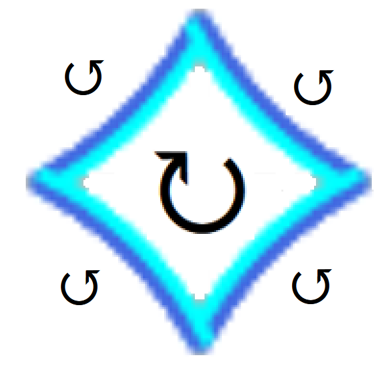PHY.K02UF Molecular and Solid State Physics
|
| ||||
PHY.K02UF Molecular and Solid State Physics | ||||
Another way to represent the Fermi surface is to plot it as a constant energy surface in reciprocal space. This page plots the Fermi surface in the extended zone scheme, the reduced zone scheme, the repeated zone scheme, and the $E\text{ vs. }k$ dispersion relation for a two-dimensional square lattice. For the free electron model in two dimensions, electron states inside the Fermi circle will be occupied, and electron states outside the Fermi circle will be empty. The radius of the Fermi circle increases as the electron density increases by adjusting the slider. The electron density \(n\) is given in units of electrons/unit cell.
The Fermi circle is plotted in an extended zone scheme, and the line changes color as it passes through the Brillouin zones. In the reduced zone scheme, the segments of the Fermi circle are translated by a reciprocal lattice vector so that they come into the first Brillouin zone. Fermi energy is plotted in a dispersion relation using the empty lattice approximation. The parts of the Fermi circle in each Brillouin zone are also plotted in repeated zone schemes.
|
Extended Zone Scheme |
Reduced Zone Scheme |
|
|
1st Brillouin Zone |
2nd Brillouin Zone |
3rd Brillouin Zone |
4th Brillouin Zone |
If a magnetic field is applied perpendicular to a two-dimensional metal, the Lorentz force $-e\vec{v}\times\vec{B}$ will push the electron in a direction that is perpendicular to the velocity of the electron $\vec{v}$ and to the magnetic field $\vec{B}$. If the magnetic field points out of the screen, free electrons will move counterclockwise in a circle under the influence of the magnetic field.

If there is a small periodic potential, band gaps will appear at the Brillouin zone boundaries. If the electron density is low, so that the Fermi circle remains in the first Brillouin zone, the electrons at the Fermi surface will move in a counterclockwise circle just like free electrons. However, suppose the electron density increases so that the Fermi circle passes into the second Brillouin zone. When electrons in the first Brillouin zone reach the Brillouin zone boundary, they can't continue in a circle from the blue line to the red line because states on the red line in the second Brillouin zone have a higher energy. Instead, the electrons diffract to the other side of the first Brillouin zone and continue from there. Due to the diffraction across the Brillouin zone, the net motion of the electron in the first Brillouin zone is clockwise.

The clockwise motion of the electrons can be detected experimentally in the magnetic response of the metal. The condition for clockwise motion occurs when the electron states of a Brillouin zone are nearly filled. The clockwise motion of the electrons of a nearly filled Brillouin zone mimics the motion of free positively charged particles. These fictitious positively charged particles are called holes. The concept of holes will be important in the discussion of semiconductors.
The Fermi circle is drawn with a dark color on the side in contact with the occupied states and a light color on the side in contact with the empty states. The states at the Fermi surface are electrons if the dark line is on the inside of a closed contour. The states at the Fermi surface are holes if the light line is on the inside of a closed contour.